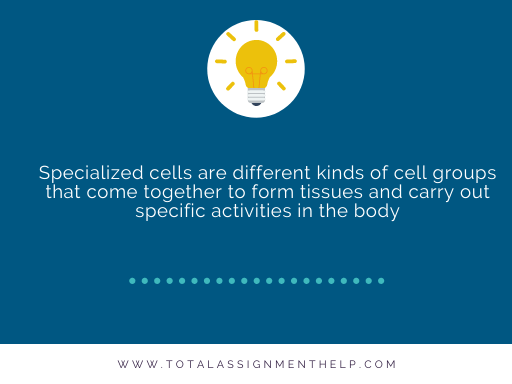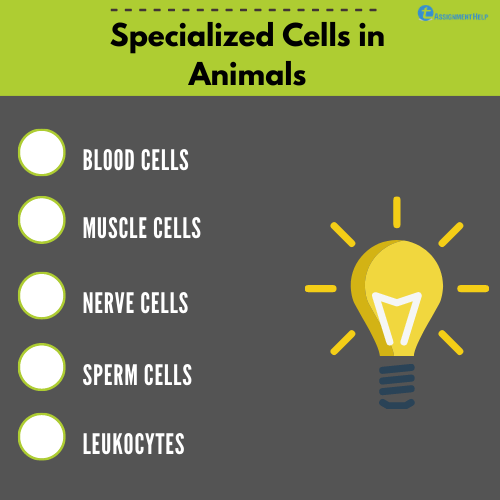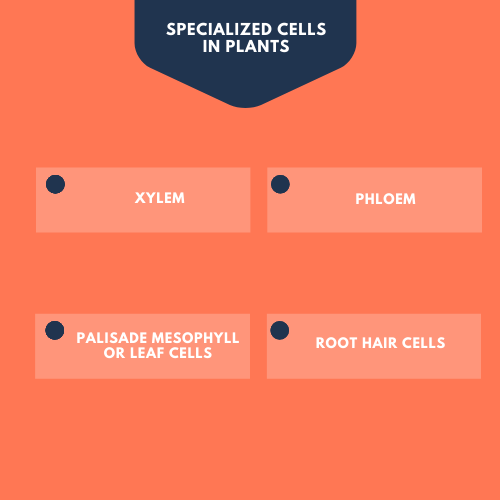Specialized Cells Contribution Towards The Basic Building Block Of Life

In well-developed organisms, there exist various kinds of cells. The union of cells form different tissues in the organism. Different cells in an organism has different characteristics and has a separate role to perform in the body. It is the similar type of cells that would together combine to form tissues. The combination of these tissues would pave the way for the generation of the organs. Even in the plants, various types of tissues could be traced. Though it is in the animals that more complex and wide varieties of tissue are traced.
Cells are the basic building block in a living body. The cells of the living beings could not be observed via naked eye. They could only be seen by using a microscope. The modern microscopes could magnify the object to the multiple level. The introduction of the modern microscopes has widened the study of cells and revealed various comprising organelles in it. The various bodies having specific roles in the cells are termed to be its organelles. The case in the unicellular organisms is that all the metabolism for its existence should be carried out in the same cell itself. Though the case is very much different in the case of a developed multicellular animal. Various kinds of cells group together to form tissues that carry out specific activities in the body. This phenomenon is widely termed to be cell specialization in the field of biology. The human body consists of around 200 types of specialized cells. The specialized cells could be classified according to the characteristics like its size, type of organelle constitute in it, its shape, the number of organelles constituted in it, etc.
Tissues
As provided earlier in this article on specialized cells, the group of cells which would work harmoniously for a single function in an organized way could be termed as tissues. A wide classification of tissues is being discussed in the below section of this report on specialized cells. The fact that the tissue may comprise of various types of specialized cells would make its study even more multifaceted.
Organs
The cluster of tissues that works harmoniously to carry out a particular function could be termed as organ. The coordination of the organs that helps in sustaining normal metabolic rate in the animal body could be termed as an organ system. For example, the tissues of heart, veins and blood tissue form together the circulatory system.
The organs like small intestine are comprised of the tissues like epithelial tissue, muscle tissue, nerve tissue, and connective tissue. The proper working of organs in a body is made possible by the coordination of various specialized cells and tissues generated from it.
Below are provided a list of specialized cells that are found specifically in animals.
Specialized cells in Animals
Blood Cells: The blood cells are found in the shape of concave capsules in humans. This concave shape of the blood corpuscles increases the oxygen-carrying capacity of the circulatory system. This concave feature would also help the blood to flow through the narrow blood capillaries. The concave shape allows the blood cells to permeate into the intracellular cell membranes. Blood could be classified as a tissue which act as a carrier for nutrients, waste materials, enzymes, and hormones. The presence of hemoglobin pigment in the blood tissue would help in making bond with the oxygen molecules. This factor would significantly increase the oxygen-carrying capacity of the blood. The absence of nucleus in the blood cells makes it permeable in between the tissues.
Muscle Cells: The cells coming under this division are majorly known as myocytes. Myocytes are the building block of the muscle tissues. The muscle tissues could be further classified into skeletal, smooth, and cardiac muscle cells. If considered the shape of the muscle cells they are observed to be very lean and thin. They are capable of contracting and elongating whose combined effort would result in movement of the body. The metabolism rate is very high in the muscle cells. To compensate the high demand of energy there are numerous mitochondria in muscle cells.
The muscle cells are observed to be in the form of long fibers in human body. The muscle cells would range from 1mm to 40 mm in size. It is based on the body position that the muscle cells display variation in its size. As mentioned above, the muscle cells are comprised of a large number of mitochondria. Some of the muscle cells consists of even 100 nuclei and this parameter highly depends on its shape and length. The organelle like myofibril could only be traced in the muscle cells. Myofibrils are cylindrical in shape and would facilitate the contraction of the muscle in a very effective way.
Nerve Cells: It is the nervous system in the body, which helps the brain in controlling the various parts of the body via impulse transmissions. The nerve cells are the building block of the vast network of nerve cells in the human body. It is the nervous system in the body which makes possible the coordinated movement of the muscle cells. The nerve cells are in the elongated shape that would facilitate the easy transfer of impulse to the various parts of the human body.
Sperm Cells: It is for the reproduction purpose that the sperm cells are present in the male human body. The main motive of the sperm cell is to fertilize the female ovary cell. For effortless transportation in the female reproductive medium, sperm cells possess an elongated tail that vigorously whips to move towards the egg. It is after the fusion of the ovum and the sperm cells that the formation of embryo and zygote takes place. The sperm cell comes under the category of haploid cells which could either consist of the X chromosomes or Y chromosomes. It is in the head of the sperm cell were the major enzymes and nucleus placed for process of fertilization.
Leukocytes: Leukocytes majorly deals with the immunity of the human body and comes under the category of white blood cells. The specialized cells of Leukocytes would act very vigorously to prevent infection if any foreign material enters into a body. It is by destroying the foreign microbes by emitting antibodies that the leukocyte specialized cells would prevent infection.
Specialized cells in Plants
Xylem: The major role of the xylem tissue is to carry water and raw nutrients from roots to the leaves. The tissues of xylem behave like a nonliving thing. Xylem are found in the form of tubules. A series or cluster of such tubules would result in the formation of xylem tissues. The cell walls of the xylem tissues are broken which would further facilitate the flow and transport of the water and nutrients.
Phloem cells: The major motive of the phloem specialized cells is also the transportation as like that of the xylem cells. Though in this case, the processed food and sugars are transported throughout the body parts where the nutrients are needed. In the case of phloem also the tissue membranes are punctured like xylem which would further facilitate the effective flow of sugar throughout the plant system. The phloem specialized cells possess a very large nucleus to coordinate and control the tissue of phloem in a very effective way.
Leaf cells or Palisade mesophyll cells: These types of specialized cells are majorly found in the topmost position of the leaves. The specific duty of the palisade mesophyll specialized cells is to carry out the crucial process of photosynthesis in most productive manner. Photosynthesis is a very crucial procedure in the plant body and any abnormality in it would perish it. These specialized cells possess chloroplast in a very large amount which would help them in carrying out the process of photosynthesis in maximum rate.
Root hair cells: Root hairs are the specialized cells that carries out the the task of absorbing water from the soil. The water collected in this manner would be used for the process of photosynthesis and transpiration in the plant body. The small hair size of the tissues would help it to increase its surface area consecutively resulting in the maximum absorption of water from its surroundings.
Let us have a detailed look at specialized cells and their scope in the practical world.
Significance of Stem cells and Meristems
Stem Cells:
The stem cells could not be classified under any specific specialized cells and are mostly found in the well-developed multicellular living organisms. As per the biological condition, the stem cells could modify itself into any specific specialized cells. This would suffice the deficiency of cells in any particular portion of the organism. Hence the stem cells could be mentioned as the production house of the specialized cells. It is by the process of mitotic cell division that various specialized cells in the human body. They are multiplied further to suffice the deficiency of the cells. It is for the filling the injuries or the growth of the whole body that the stem cells are majorly utilized in a living body. The specialized cell could be transformed into any type of cell whether it is the epithelial cell, Ligament cells, Bone cells, Marrow cells, Cartilage cells, Fat cells, etc.
Scope of stem cells: In the modern medical discipline, the stem cells are majorly implied in the field of cancer treatment. By the means of the stem cells (transplanted via bone marrow) the cells in the body are retained in the cancer patients which they had lost at the time of treatment. Because of the wide scope and implacability of the stem cells, they could be utilized for other hazardous diseases among the human body. The scope of stem cells is listed down in the below section of this report on specialized cells.
- Used in developing the organs into its complete maturity. This technology would eliminate the requirement of an organ donor and risks involved in the process of organ transplants.
- Among heart patients, who have suffered a considerable loss of cardiac tissue because of the heart attack. The stem cells would be very effective in developing the cardiac tissue.
- If the individual has suffered considerable tissue damage because of the burns, the damage could be covered by implying the use of stem cells.
The method through which the stem cells are extracted is still considered as a taboo since they are obtained from the embryo. The method could be technically stated as infanticide and has raised much criticism from many religious, communal, and even scholar communities. The main reason behind all this criticism is because of the killing of potential and living embryos.
Meristems: It is the meristematic cells that contribute to the growth of plant by the method of cellular division. The meristematic cells also generate unspecialized cells which would turn out to be any specialized cell as per the requirement of the plant body. The meristematic cell could turn into any cell-like phloem cell, leaf mesophylls, xylem cells, root cells, etc. Meristematic cells are majorly found in the plant parts like shoot tips and root tips where the growth process majorly takes place. The specific places where the meristematic cells could be observed or traced are apical area of the shoot and root tips, the lateral area of the matured stem, intercalary area in between the stem nodes, etc. In the apical area of the plant, the meristematic cell would contribute towards the creation of the required specialized cells. Since the primary plant body is generated in this area, the allocated meristematic cells would come under the category of primary meristems. The secondary meristems could be traced at the lateral area of the stem and contribute to the lateral growth resulting in increased thickness and hardness. The meristems could also be found in the specific places where the plants are majorly injured. Though the growth is limited in animals after a certain age, the plants keep on growing in their entire life span. This is made possible because of the infinite presence of meristematic cells at various sites of the plant body. If taken the shape of the meristematic cells, the comparatively very small and retains a circular shape. Their potential could be traced from very dense packed cytoplasm where no vacuoles could be traced. It is by the mitotic cell division by which the meristematic cells keep on supplying fresh cells.






